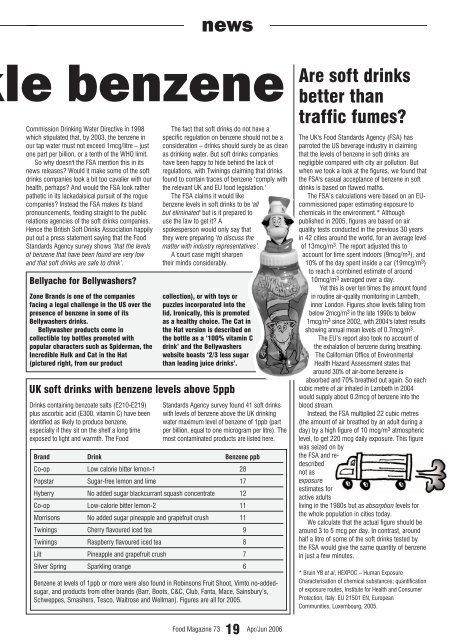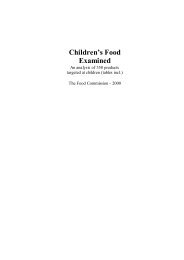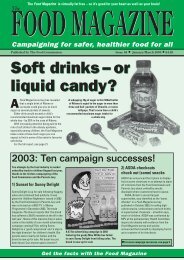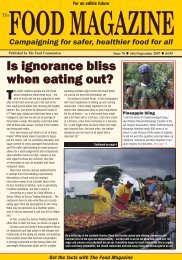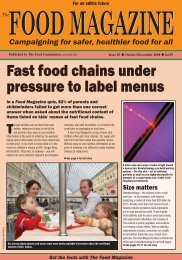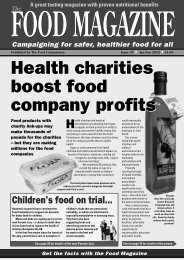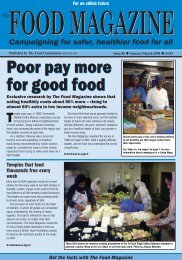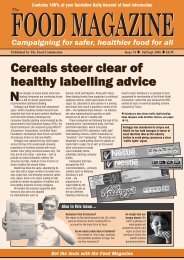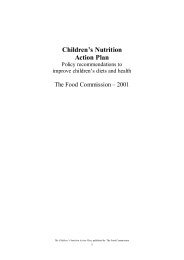Campaigning for safer, healthier food for all - The Food Commission
Campaigning for safer, healthier food for all - The Food Commission
Campaigning for safer, healthier food for all - The Food Commission
Create successful ePaper yourself
Turn your PDF publications into a flip-book with our unique Google optimized e-Paper software.
news<br />
le benzene<br />
<strong>Commission</strong> Drinking Water Directive in 1998<br />
which stipulated that, by 2003, the benzene in<br />
our tap water must not exceed 1mcg/litre – just<br />
one part per billion, or a tenth of the WHO limit.<br />
So why doesn't the FSA mention this in its<br />
news releases? Would it make some of the soft<br />
drinks companies look a bit too cavalier with our<br />
health, perhaps? And would the FSA look rather<br />
pathetic in its lackadaisical pursuit of the rogue<br />
companies? Instead the FSA makes its bland<br />
pronouncements, feeding straight to the public<br />
relations agencies of the soft drinks companies.<br />
Hence the British Soft Drinks Association happily<br />
put out a press statement saying that the <strong>Food</strong><br />
Standards Agency survey shows ‘that the levels<br />
of benzene that have been found are very low<br />
and that soft drinks are safe to drink’.<br />
Bellyache <strong>for</strong> Bellywashers?<br />
Zone Brands is one of the companies<br />
facing a legal ch<strong>all</strong>enge in the US over the<br />
presence of benzene in some of its<br />
Bellywashers drinks.<br />
Bellywasher products come in<br />
collectible toy bottles promoted with<br />
popular characters such as Spiderman, the<br />
Incredible Hulk and Cat in the Hat<br />
(pictured right, from our product<br />
<strong>The</strong> fact that soft drinks do not have a<br />
specific regulation on benzene should not be a<br />
consideration – drinks should surely be as clean<br />
as drinking water. But soft drinks companies<br />
have been happy to hide behind the lack of<br />
regulations, with Twinings claiming that drinks<br />
found to contain traces of benzene ‘comply with<br />
the relevant UK and EU <strong>food</strong> legislation.’<br />
<strong>The</strong> FSA claims it would like<br />
benzene levels in soft drinks to be '<strong>all</strong><br />
but eliminated' but is it prepared to<br />
use the law to get it? A<br />
spokesperson would only say that<br />
they were preparing ‘to discuss the<br />
matter with industry representatives’.<br />
A court case might sharpen<br />
their minds considerably.<br />
collection), or with toys or<br />
puzzles incorporated into the<br />
lid. Ironic<strong>all</strong>y, this is promoted<br />
as a healthy choice. <strong>The</strong> Cat in<br />
the Hat version is described on<br />
the bottle as a ‘100% vitamin C<br />
drink’ and the Bellywashers<br />
website boasts ‘2/3 less sugar<br />
than leading juice drinks’.<br />
UK soft drinks with benzene levels above 5ppb<br />
Drinks containing benzoate salts (E210-E219)<br />
plus ascorbic acid (E300, vitamin C) have been<br />
identified as likely to produce benzene,<br />
especi<strong>all</strong>y if they sit on the shelf a long time<br />
exposed to light and warmth. <strong>The</strong> <strong>Food</strong><br />
Standards Agency survey found 41 soft drinks<br />
with levels of benzene above the UK drinking<br />
water maximum level of benzene of 1ppb (part<br />
per billion, equal to one microgram per litre). <strong>The</strong><br />
most contaminated products are listed here.<br />
Brand Drink Benzene ppb<br />
Co-op Low calorie bitter lemon-1 28<br />
Popstar Sugar-free lemon and lime 17<br />
Hyberry No added sugar blackcurrant squash concentrate 12<br />
Co-op Low-calorie bitter lemon-2 11<br />
Morrisons No added sugar pineapple and grapefruit crush 11<br />
Twinings Cherry flavoured iced tea 9<br />
Twinings Raspberry flavoured iced tea 8<br />
Lilt Pineapple and grapefruit crush 7<br />
Silver Spring Sparkling orange 6<br />
Benzene at levels of 1ppb or more were also found in Robinsons Fruit Shoot, Vimto no-addedsugar,<br />
and products from other brands (Barr, Boots, C&C, Club, Fanta, Mace, Sainsbury’s,<br />
Schweppes, Smashers, Tesco, Waitrose and Wellman). Figures are <strong>all</strong> <strong>for</strong> 2005.<br />
Are soft drinks<br />
better than<br />
traffic fumes?<br />
<strong>The</strong> UK's <strong>Food</strong> Standards Agency (FSA) has<br />
parroted the US beverage industry in claiming<br />
that the levels of benzene in soft drinks are<br />
negligible compared with city air pollution. But<br />
when we took a look at the figures, we found that<br />
the FSA's casual acceptance of benzene in soft<br />
drinks is based on flawed maths.<br />
<strong>The</strong> FSA’s calculations were based on an EUcommissioned<br />
paper estimating exposure to<br />
chemicals in the environment.* Although<br />
published in 2005, figures are based on air<br />
quality tests conducted in the previous 30 years<br />
in 42 cities around the world, <strong>for</strong> an average level<br />
of 13mcg/m 3 . <strong>The</strong> report adjusted this to<br />
account <strong>for</strong> time spent indoors (9mcg/m 3 ), and<br />
10% of the day spent inside a car (19mcg/m 3 )<br />
to reach a combined estimate of around<br />
10mcg/m 3 averaged over a day.<br />
Yet this is over ten times the amount found<br />
in routine air-quality monitoring in Lambeth,<br />
inner London. Figures show levels f<strong>all</strong>ing from<br />
below 2mcg/m 3 in the late 1990s to below<br />
1mcg/m 3 since 2002, with 2004's latest results<br />
showing annual mean levels of 0.7mcg/m 3 .<br />
<strong>The</strong> EU’s report also took no account of<br />
the exhalation of benzene during breathing.<br />
<strong>The</strong> Cali<strong>for</strong>nian Office of Environmental<br />
Health Hazard Assessment states that<br />
around 30% of air-borne benzene is<br />
absorbed and 70% breathed out again. So each<br />
cubic metre of air inhaled in Lambeth in 2004<br />
would supply about 0.2mcg of benzene into the<br />
blood stream.<br />
Instead, the FSA multiplied 22 cubic metres<br />
(the amount of air breathed by an adult during a<br />
day) by a high figure of 10 mcg/m 3 atmospheric<br />
level, to get 220 mcg daily exposure. This figure<br />
was seized on by<br />
the FSA and redescribed<br />
not as<br />
exposure<br />
estimates <strong>for</strong><br />
active adults<br />
living in the 1980s but as absorption levels <strong>for</strong><br />
the whole population in cities today.<br />
We calculate that the actual figure should be<br />
around 3 to 5 mcg per day. In contrast, around<br />
half a litre of some of the soft drinks tested by<br />
the FSA would give the same quantity of benzene<br />
in just a few minutes.<br />
* Bruin YB et al, HEXPOC – Human Exposure<br />
Characterisation of chemical substances; quantification<br />
of exposure routes, Institute <strong>for</strong> Health and Consumer<br />
Protection, Italy. EU 21501 EN, European<br />
Communities, Luxembourg, 2005.<br />
<strong>Food</strong> Magazine 73 19<br />
Apr/Jun 2006


